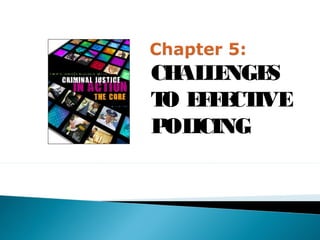
Chapter5
- 1. CH L NGE AL E S T E F CT O F E IVE P ICING OL
- 2. Basic Requirements ◦ Educational Requirements ◦ Training Academy Training In the Field Training
- 3. Identify the differences between the police academy and field training as learning tools for recruits.
- 4. Police Academy: Field Training: ◦ Laws of arrest, search, ◦ The field training officer seizure, and interrogation (FTO) helps the rookie ◦ Weapons use apply what s/he has ◦ Crime scene preservation learned “in the streets.” ◦ Witness interviewing ◦ First aid ◦ Self-defense
- 5. Explain the benefits of a culturally diverse police force.
- 6. Benefits of a culturally diverse police force include: ◦ Improved community relations ◦ Higher levels of service
- 7. Women in Policing Legal Discrimination
- 9. List the three primary purposes of police patrol.
- 10. Police on Patrol The Purpose of Patrol ◦ To deter crime by maintaining a visible presence ◦ To maintain public order and a sense of security ◦ To provide services that are not crime-related
- 11. Routine patrol activities can be categorized into four areas: ◦ Preventive patrol ◦ Calls for service ◦ Administrative duties ◦ Officer-initiated activities
- 12. Aggressive Investigation Strategies Clearance Rates and Cold Cases ◦ More than 80 percent of large-city police departments have cold case squads dedicated to unsolved crimes
- 13. Forensic Investigations and DNA – the use of science and technology to investigate crimes ◦ Crime Scene Forensics For more than a century the most important piece of trace evidence has been the human fingerprint
- 14. Describe how forensic experts use DNA fingerprinting to solve crimes.
- 15. DNA fingerprinting uses a suspect’s DNA to match the suspect to a crime Emerged in the mid-1990s A match can be as conclusive as 30 billion to one
- 17. Questions: ◦ Was there anything clarified for you in the video that you had a misconception about based on a primetime television show? ◦ Reflect on how fingerprint technology has revolutionized the criminal justice system and investigative abilities of law enforcement officers.
- 19. Questions: ◦ How would the mass application of the types of technology shown in the video change the criminal justice system? ◦ Are there any foreseeable disadvantages to the use of these types of technologies?
- 20. Response Time to 911 Calls Patrol Strategies ◦ Testing General Patrol Theories in Kansas City ◦ “Hot Spots” and Crime Mapping Arrest Strategies ◦ The Broken Windows Effect ◦ Supporters and Critics
- 21. Explain community policing and its contribution to the concept of problem-oriented policing.
- 22. Community policing is a philosophy that emphasizes community support for and cooperation with the police in preventing crime. ◦ Less centralized ◦ Proactive
- 23. Problem-Oriented Policing: • A key component of community policing • Moves beyond simply responding to incidents and attempts instead to control or even solve the root causes of criminal behavior • Two important aspects of problem-solving policing are “hot spots” and crime mapping
- 24. Police Subculture - the values and perceptions that are shared by members of a police department; these values permeate agencies and are taught to new officers through a process of socialization. The Core Values of Police Subculture Police Cynicism
- 25. The Physical Dangers of Police Work The Stress of Police Work
- 26. Determine when police officers are justified in using deadly force.
- 27. The “Misuse” of Force ◦ Occurs in only 1.6% of police-public encounters Types of Force ◦ Reasonable force – the degree of force that is appropriate to protect the police officer or other citizens and is not excessive ◦ Deadly force – force applied by a police officer that is likely or intended to cause death
- 29. The United States Supreme Court and Use of Force: Tennessee v. Garner (1985) Graham v. Conner (1989)
- 30. Identify the three traditional forms of police corruption.
- 31. Types of corruption: ◦ Bribery ◦ Shakedowns ◦ Mooching
- 32. Explain what an ethical dilemma is, and name four categories of ethical dilemmas typically facing a police officer.
- 33. Ethical dilemmas are defined as a situation in which law enforcement officers: • Do not know the right course of action • Have difficulty doing what they consider to be right; and/or • Find the wrong choice very tempting
- 34. Four categories of ethical dilemmas: Discretion Duty Honesty Loyalty
